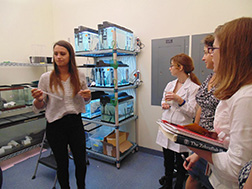Top photo courtesy Eckerd College. Along with freshwater fish and coral larva, Eckerd students looked at the impact of shampoo ingredients on Caenorhabditis elegans, a nematode that mimics life processes of more advanced species.
When Eckerd alumni and cosmetic chemist Autumn Blum decided to create a new line of eco-conscious skincare products, she selected ingredients that were considered to be the safest available.
Turns out they might be safe for people, but her first three shampoo formulations killed entire tanks of zebrafish when she tested them for aquatic toxicity. “I discovered the hard way that products that are safe for people aren’t necessarily safe in the environment,” she said.
Blum turned to professors and students at Eckerd to push the limits on testing ingredients in a line being developed for outdoor enthusiasts. “This is really ground-breaking research,” says Denise Flaherty, biology professor. “There are very few rules that we can follow so we’re making thoughtful choices as we go along.”
Even developing a reasonable exposure was a learning process. “We didn’t want to dump a bottle of shampoo in a tank of fish, but we did want to test for the maximum likely exposure,” Flaherty said. “We ended up measuring a handful of shampoo, estimating the number of gallons in a bathtub full of water, and water faucet flow rates documented by the EPA. Then we worked it back down to milliliters of shampoo and liters of water in a fish tank.”
Tanks were checked for dead fish, as well as those swimming erratically or not eating, at 3, 6, 12, 24, 48, 72 and 96 hours – and cheers erupted when all the fish were darting around the tanks and eating at the end of the test.
Testing for sunscreens is even more challenging. Researchers at the National Oceanic and Atmospheric Administration have already documented that even very low concentrations of a common ingredient in chemical sunscreens — benzophenone-2, or BP-2 – quickly kills juvenile corals. BP-2 also causes colorful coral to bleach by awakening dormant viruses in the symbiotic algae that create the coral’s color.
“We absolutely knew we were going to avoid that kind of chemical, but even the mineral sunscreens can be toxic in an aquatic ecosystem,” Blum said. “For instance, zinc is a naturally occurring mineral and very safe in an aquatic environment — unless it’s a non-whitening zinc that’s been coated to eliminate the ‘white-nosed lifeguard’ look. Even the MSDS (material safety data sheet) for that ingredient lists aquatic toxicity on the first page in red ink.”
Her sunscreens passed the first phase with flying colors, even at the highest concentration tested: no dead fish in a tank with the equivalent of an ounce of sunscreen in three bathtubs full of water.
But Blum wondered if freshwater fish would show the same reaction as more vulnerable coral larva?

A second series of tests will begin in May when Eckerd professor Koty Sharp takes a team of student divers to Mote Marine’s Tropical Research Station on Summerland Key to collect corals and bring them back to the lab. When the corals release larvae, the larvae will be placed into dishes containing substrates that have been proven to be attractive to the larvae.
“For many years, we’ve been collaborating with Smithsonian Institution researchers to identify different processes and organisms on coral reefs that help coral larvae select one substrate or another for successful settlement and growth – a process called recruitment. And some coral larvae are very picky,” Sharp said. “We don’t know yet how sunscreen in reef water could influence coral larval settlement. However, we do know that even a very small concentration of some chemicals can influence bacterial metabolism on these surfaces, and we have found that bacterial communities on reefs directly impact the settlement behavior and survival of coral larvae.”
Sharp and her students are currently conducting an in-depth review of the literature to determine how much sunscreen can be released from divers onto a reef, but lab testing will take concentrations to the maximum level imaginable.
“This is very exciting work on a number of levels,” she said. “For our undergraduates, doing field experiments allows them to apply what they’ve learned in their coursework at Eckerd College to address real-world questions. Our hope is that through this research, we are providing consumers a chance to see that choosing reef-safe products is an important step for conserving our precious reef ecosystems.”
Dive trip led to research
The stimulus for the product line – called Stream2Sea – was a dive trip Blum took to Palau, one of the healthiest coral reefs in the world. “I was watching other divers wash their hair with suds running straight overboard, then they’d slather themselves with sunscreens packed with chemicals I knew weren’t safe.”
The founder of Organix-South, Blum had grown a one-woman business into the nation’s largest manufacturer of neem products, in large part by carefully researching ingredients in her skin care products. When she got back to the US, she searched for products that wouldn’t harm underwater ecosystems, and was even more surprised to see sunscreens labeled “reef-safe” containing ingredients that weren’t.
“The process of formulating the products isn’t moving as quickly as we had hoped, but we’re setting a new standard for safety,” Blum said. “No one has ever done the kind of testing we’re doing now – hopefully we’ll help set the stage for other companies to follow by providing in-depth information on why we’ve selected these ingredients.”
